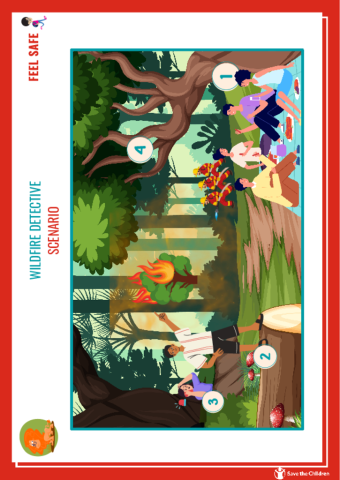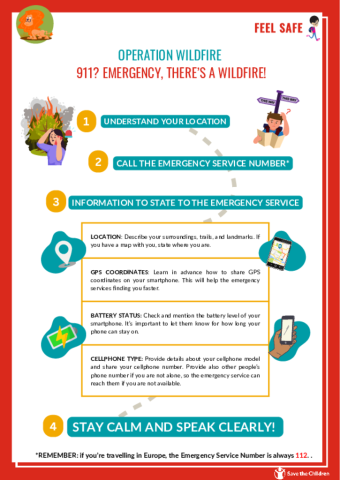Operation Wildfire
Objectives:
- Equip kids with the knowledge and skills to handle an emergency situation in the woods
STEP BY STEP
Before starting
The teacher starts by asking children to indicate what they would take with them if they went on a hike or picnic in the woods. Answers can be written on the blackboard.
A safe trip in the woods
The teacher explains that children will " be "exploring the woods" and learning what to do and how to prepare in case of a wildfire. The teacher may decide to carry out the activity in an open space (e.g., the school garden) to make the experience more engaging or project the available Scenario on the blackboard (see attached "Operation Wildfire - Scenario" below).
The teacher then presents the scenario. It represents a spotting of a wildfire in the woods, in the nearby vicinity of where some children are having a picnic. After spotting the fire, the teacher begins to discuss with the class the correct actions and behaviors to take in the event of a forest fire.
The teacher can follow the following steps to guide the discussion.
-
Fire safety A condition that makes one feel that one is not in danger or that a risk can be prevented or reduced discussion. The teacher explains the importance of knowing the basics of fire safety in the woods, including creating a fire barrier, staying low to the ground if smoke covers the nose and mouth, finding a clearing away from trees, and avoiding using flammable materials. Each child can name one correct behavior to know before going into the woods and the teacher can write it on a poster board or paper (the teacher may decide to use a poster board to hang in the classroom at the end of the activity or use a paper, a copy of which can be given to the children).
Understand your own position. At this point, the teacher can draw an imaginary map in which they will highlight where the woods area is, pointing out the trails, picnic area and landmarks. Children will have to discover the safest escape route An obstacle-free route that, together with correct behaviour, allows people to evacuate safely . The teacher can discuss the basics of determining directions using a compass (if available).
- Information to share. After getting all the information about the correct behaviors and their location, children can pretend to call the emergency number. The teacher provides children with a list of information they need to share with the emergency service during the call:
- Location: Describe the surroundings, trails and landmarks and use the map (if you have one) to determine your location.
- GPS coordinates: Find GPS coordinates on your smartphone, if you have sufficient battery or signal.
- Battery Status: Check and report the battery level to the emergency operator.
- Cell phone model: Provide details about your smartphone model. This can be helpful in tracking you down more easily.
- Simulation of a call. After collecting all the necessary information, children can pretend to call the emergency number. It is important to remember the local emergency number (for example, 115 to call the Fire Brigade in Italy), but children should keep in mind that 112 is the European emergency number that they can call from any European country. Divided into pairs, children can perform a simulated emergency call. One of the participants pretends to spot a fire and calls the other, who acts as the dispatcher. The emergency dispatcher should ask for the information gathered in the previous steps, and the other should provide the information as clearly as possible. It is crucial for the teacher to stress the importance of keeping calm and speaking slowly. The pair takes turns in roles to practice.
- Use of reflective materials. The teacher now explains the benefits of using reflective materials or bright clothing to make oneself visible to rescue teams. These materials can be worn before going into the woods (e.g., reflective vests) or used to keep warm or cool while waiting to be rescued. The teacher can also show children how to wear these materials properly.
Concluding thoughts
At the end of the activity, the teacher can discuss with the children what they have learned about emergency calls, fire safety A condition that makes one feel that one is not in danger or that a risk can be prevented or reduced and preparedness in the forest. To guide the discussion, the teacher can share the "112? Help, there's a fire!" sheet (see attached "Operation Wildfire - 112? Help, there's a wildfire!" below).


Add new comment